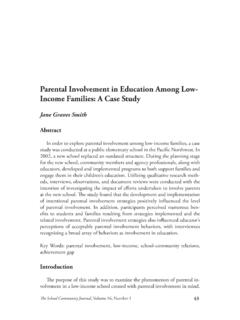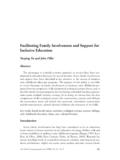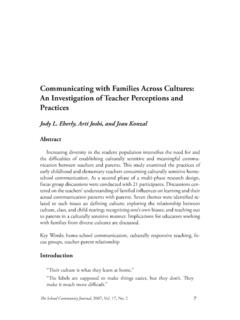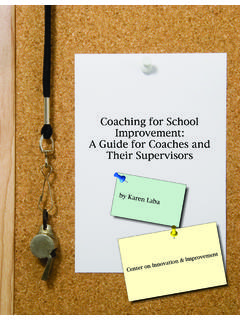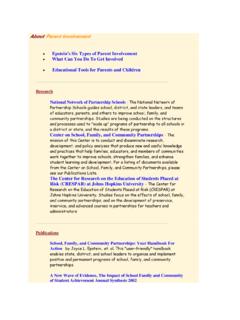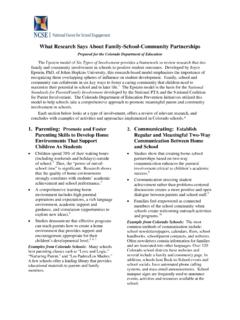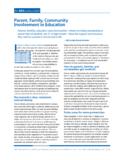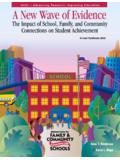Transcription of Having Their Say: Parents Describe Why and How They are ...
1 The school community journal3435 Having Their Say: Parents Describe Why and How They are Engaged in Their Children s LearningKaren L. MappAbstractThe purpose of this study was to identify factors that lead to successful edu-cational partnerships between school staff and families. The method for this investigation focused on asking Parents how and why they were involved in Their children s education and what factors influenced Their participation. The study was conducted at the Patrick O Hearn Elementary School, in Boston, MA, where, according to yearly survey data collected by the school, at least 90% of the Parents participated in one or more of the home- or school-based family engagement activi-ties, despite the school s urban, low socioeconomic setting.
2 By gathering Parents own descriptions of Their participation in Their children s education, this research study sought to develop a deeper understanding of the Parents perceptions of involvement and explored whether Their descriptions would match existing typol-ogies or fall outside existing definitions. Another goal of the research was to inves-tigate factors that influenced Parents involvement in Their children s findings from this study strongly support prior research showing that the majority of Parents want Their children to do well in school and have a desire to help Their children succeed.
3 The findings also indicate that O Hearn Parents understood clearly that Their involvement helped Their children s educational development. The most significant findings from the study indicate that, according to the the school community journal36parents Describe involvement37eighteen Parents interviewed, several social and school factors influence why and how they are involved in Their children s education. According to the Parents , when school personnel initiate and engage in practices that welcome Parents to the school, honor Their contributions, and connect them to the school community through an emphasis on the children, these practices then cultivate and sustain respectful, caring, and meaningful relationships between Parents and school staff.
4 While many schools place the emphasis on the programming portion of Their family involvement initiative, the data from this case study reveals that when Parents have caring and trustful relationships with school staff, these relationships enhance Their desire to be involved and influence how they participate in Their children s educa-tional development. The intent of this study was to yield an understanding of factors that contribute to the development of partnership between families and schools. This study pro-vides critical information for Parents , teachers, policy makers, and school officials attempting to design and implement family involvement initiatives, as well as impli-cations for further Words: home-school partnerships, family involvement , parent involvementIntroductionIn the last decade, there has been a renewed national focus on the role that fami-lies play in Their children s educational development.
5 More than three decades of research show that, regardless of economic, racial/ethnic, and educational back-grounds, there is a strong link between educational benefits to children and vari-ous forms of family engagement such as encouragement to succeed academically, involvement in at-home activities such as help with homework, volunteerism in schools, and participation in governance activities (Cochran & Henderson, 1986; Eagle, 1989; Epstein, 1996; Epstein, Simon, & Salinas, 1997; Gotts, 1989; Hen-derson & Berla, 1994; Henderson & Mapp, 2002; Hewitt, 1978; Ho & Willms, 1996; Jordan, Orozco, & Averett, 2002; McDill, Rigsby, & Meyers, 1969; Melnick & Fiene, 1990; Mowry, 1972; Schweinhart & Weikart, 1992).
6 The educational benefits to children include higher grades and test scores, better school attendance, higher graduation rates, greater enrollment in postsecondary education, and more positive attitudes about school (Henderson & Berla, 1994; Henderson & Mapp, 2002). As a result of this link between family engagement and student outcomes, several of the current whole-school comprehensive reform efforts identify school, family, and community partnership as a component of successful schools. For example, the Comprehensive School Reform Demonstration Program (Obey-the school community journal36parents Describe involvement37 Porter Act of 1998) identifies parent and community involvement as one of its eight design requirements for strategies used by schools committed to achieving high standards for all students.
7 Despite this emphasis on partnership between schools and families, teachers, principals, and Parents attempting to coordinate family involvement initiatives express frustration at low levels of success in creating programs that forge mean-ingful and lasting connections with families. In some cases, the failure of these pro-grams to take hold is attributed to low levels of involvement on the part of families. This claim of minimal family involvement is particularly heard in school systems serving low-income and minority families (Chavkin & Williams, 1993; Comer, 1980; Davies, 2001; Lareau, 1987; Lawrence-Lightfoot, 1978; Lopez, 2001).
8 Purpose of the StudyGiven the new focus on the role of families in Their children s educational development, the purpose of this study was to identify factors that lead to suc-cessful educational partnership between school staff and families. The method for this investigation focused on asking Parents why and how they were involved in Their children s education and what factors influenced Their participation. (Please note that in this study the term parent refers to any adult caregiver.) The study was conducted from 1996 to 1999 at the Patrick O Hearn Elementary School in Boston, Massachusetts.
9 According to yearly survey data collected by O Hearn, at least 90% of the Parents participated in one or more of the home- or school-based family engagement activities. This urban, full inclusion K-5 school served a stu-dent body of 220 students in which approximately 67% of the students, based on family income, qualified for free or reduced-price lunch. The school population was racially diverse. Fifty-five percent of the students were African American, 34% were Caucasian, 6% were Hispanic and 5% were Asian. Twenty-five percent of the 220 students were categorized as special needs children.
10 Between 1989 and 1995, the O Hearn School s average median percentile scores on the Massachusetts Achievement Test for students in grades one through five rose eighteen percentage points in English (from 44 to 62) and thirty-one points in math (from 48 to 79).The O Hearn Elementary School offered a rich setting in which to ask low-income Parents about why and how they were involved in Their children s educa-tion and to explore factors influencing Their participation because the majority of its school population is eligible for free or reduced lunch, it boasts a 90% rate of family involvement , and has demonstrated improvement in student achievement.
